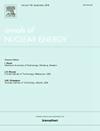Adjoint-based path length stretching in a Woodcock framework with SIRS angular biasing
IF 1.9
3区 工程技术
Q1 NUCLEAR SCIENCE & TECHNOLOGY
引用次数: 0
Abstract
The development of an adjoint-based path-stretching scheme within a non-analog Woodcock (delta-tracking) framework is predicated on zero-variance formalism. The derivation of an ideal cross-section stretching factor is possible from the incident and the outgoing adjoint collision densities. The incorporation of this bias into the virtual collision decision probability necessitates time-consuming oversampling (high sampling cross section) to achieve low variance. Conversely, a similar effect can be achieved by stretching the sampling cross section, which, however, results in a considerable increase in variance, even for minor discrepancies between the actual local and the sampling cross sections. To mitigate this, a combination of the two bias methods is necessary. Nevertheless, sensitivity to the difference between sampling and actual cross sections persists, which limits the maximum efficiency gain. To address this challenge, a Sampling Importance Resampling (SIRS) scheme was devised for angular biasing, as both transport and collision kernels necessitate biasing for a significant enhancement in efficiency. The efficacy of the algorithm is demonstrated through numerical examples for source-detector systems, employing realistic geometries and utilizing the GUARDYAN code.
求助全文
约1分钟内获得全文
求助全文
来源期刊

Annals of Nuclear Energy
工程技术-核科学技术
CiteScore
4.30
自引率
21.10%
发文量
632
审稿时长
7.3 months
期刊介绍:
Annals of Nuclear Energy provides an international medium for the communication of original research, ideas and developments in all areas of the field of nuclear energy science and technology. Its scope embraces nuclear fuel reserves, fuel cycles and cost, materials, processing, system and component technology (fission only), design and optimization, direct conversion of nuclear energy sources, environmental control, reactor physics, heat transfer and fluid dynamics, structural analysis, fuel management, future developments, nuclear fuel and safety, nuclear aerosol, neutron physics, computer technology (both software and hardware), risk assessment, radioactive waste disposal and reactor thermal hydraulics. Papers submitted to Annals need to demonstrate a clear link to nuclear power generation/nuclear engineering. Papers which deal with pure nuclear physics, pure health physics, imaging, or attenuation and shielding properties of concretes and various geological materials are not within the scope of the journal. Also, papers that deal with policy or economics are not within the scope of the journal.
 求助内容:
求助内容: 应助结果提醒方式:
应助结果提醒方式:


